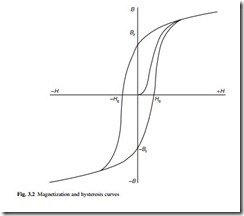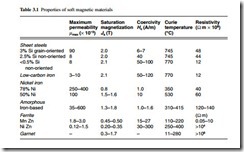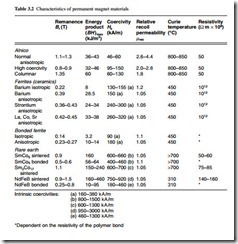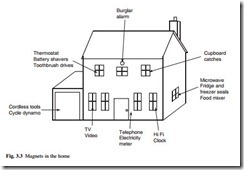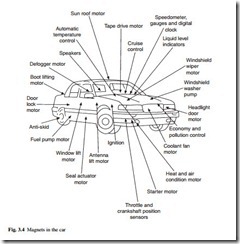Materials for electrical engineering
Introduction
Most types of electrical equipment rely, for their safe and efficient performance, on an electrical circuit and the means to keep this circuit isolated from the surrounding materials and environment. Many types of equipment also have a magnetic circuit, which is linked to the electrical circuit by the laws outlined in Chapter 2.
The main material characteristics of relevance to electrical engineering are therefore those associated with conductors for the electrical circuit, with the insulation system necessary to isolate this circuit and with the specialized steels and permanent magnets used for magnetic circuit.
Other properties, such as mechanical, thermal and chemical properties are also relevant, but these are often important in specialized cases and their coverage is best left to other books which address these areas more broadly. The scope of this chapter is restricted to the main types and characteristics of conductors, insulation systems and magnetic materials which are used generally in electrical plant and equipment.
Magnetic materials
All materials have magnetic properties. These characteristic properties may be divided into five groups as follows:
● diamagnetic
● paramagnetic
● ferromagnetic
● antiferromagnetic
● ferrimagnetic
Only ferromagnetic and ferrimagnetic materials have properties which are useful in practical applications.
Ferromagnetic properties are confined almost entirely to iron, nickel and cobalt and their alloys. The only exceptions are some alloys of manganese and some of the rare earth elements.
Ferrimagnetism is the magnetism of the mixed oxides of the ferromagnetic elements. These are variously called ferrites and garnets. The basic ferrite is magnetite, or Fe3O4, which can be written as FeO .Fe2O3. By substituting the FeO with other divalent oxides, a wide range of compounds with useful properties can be produced. The main advantage of these materials is that they have high electrical resistivity which minimizes eddy currents when they are used at high frequencies.
The important parameters in magnetic materials can be defined as follows:
● permeability – this is the flux density B per unit of magnetic field H, as defined in eqns 2.14 and 2.15. It is usual and more convenient to quote the value of relative permeability mr, which is B/moH. A curve showing the variation of permeability with magnetic field for a ferromagnetic material is given in Fig. 3.1. This is derived from the initial magnetization curve and it indicates that the permeability is a variable which is dependent on the magnetic field. The two important values are the initial permeability, which is the slope of the magnetization curve at H = 0, and the maximum permeability, corresponding to the knee of the magnetization curve.
● saturation – when sufficient field is applied to a magnetic material it becomes saturated. Any further increase in the field will not increase the magnetization and any increase in the flux density will be due to the added field. The saturation magnetization is Ms in amperes per metre and Js or Bs in tesla.
● remanence, Br and coercivity, Hc – these are the points on the hysteresis loop shown in Fig. 3.2 at which the field H is zero and the flux density B is zero, respectively. It is assumed that in passing round this loop, the material has been saturated. If this is not the case, an inner loop is traversed with lower values of remanence and coercivity.
Ferromagnetic and ferrimagnetic materials have moderate to high permeabilities, as seen in Table 3.1. The permeability varies with the applied magnetic field, rising to a maximum at the knee of the B–H curve and reducing to a low value at very high fields. These materials also exhibit magnetic hysteresis, where the intensity of magnetization of the material varies according to whether the field is being increased in a positive sense or decreased in a negative sense, as shown in Fig. 3.2. When the magnetization is cycled continuously around a hysteresis loop, as for example when the applied field arises from an alternating current, there is an energy loss proportional to the area of the included loop. This is the hysteresis loss, and it is measured in joules per cubic metre. High hysteresis loss is associated with permanent magnetic characteristics exhibited by materials commonly termed hard magnetic materials, as these often have hard mechanical properties. Those materials with low hysteresis loss are termed soft and are difficult to magnetize permanently.
Ferromagnetic or ferrimagnetic properties disappear reversibly if the material is heated above the Curie temperature, at which point it becomes paramagnetic, that is effectively non-magnetic.
Soft (high permeability) materials
There is a wide variety of soft magnetic materials for applications from constant dc field through 50/60 Hz up to microwave frequencies. For the bulk of applications iron, steel or cast iron are used. They have the advantage of low cost and strength, but they should only be used for dc applications since they have low electrical resistivity which would result in eddy currents if used in alternating fields.
In choosing a high-permeability material for a particular application there may be special considerations. If the frequency of the applied voltage is 10 kHz or above, then ferrites or garnets will normally be used. For constant-field applications mild steel is used, and low-carbon iron is used where the highest permeability or lowest coercivity is needed. For 50/60 Hz power transformers, grain-oriented silicon steel is used, but there is now serious competition from amorphous strip and although this is more expensive the core loss is significantly lower than that of silicon steel. For the highest permeability and lowest coercivity in specialist applications up to about 10 kHz nickel iron would be the preferred choice although its cost may be prohibitive.
Sheet steels
There are a number of grades of sheet steel and these comprise by far the greatest part of the soft, high-permeability material used. These metallic materials have a compara- tively low electrical resistivity and they are used in sheet (or lamination) form because this limits the flow of eddy currents and the losses that result. The range of sheet thick- ness used for 50/60 Hz applications is 0.35–0.65 mm for non-oriented materials and 0.13–0.35 mm for grain-oriented silicon steels. For higher frequencies of 400–1000 Hz thicknesses of 0.05–0.20 mm are used.
In grain-oriented steel an increasing level of silicon content reduces the losses but also reduces the permeability; for many applications a 3 per cent silicon content rep- resents a good balance. The effect of silicon is to increase the electrical resistivity of steel; not only does this reduce eddy current losses but it also improves the stability of the steel and aids the production of grain orientation. The sheet is subject to cold rolling and a complex annealing treatment to produce the grain orientation in the rolling direc- tion and this also gives improved magnetic permeability in that direction. The properties are further improved at the annealing stage with a glass film on the surface that holds the steel in a state of tension and provides electrical insulation between laminations in a core. A phosphate coating is applied to complete the tensioning and insulation. The grain size in the resulting sheets is comparatively large and the domain boundaries are quite widely spaced. Artificial grain boundaries can be produced by laying down lines of ablated spots on the steel surface; the resulting stress and atomic disruption pattern pins domain walls and leads to a smaller wall spacing. Various methods have been used to produce this ablating, including spark and laser techniques. All these processes are applied within the steel manufacturer’s works and the resulting steel is often referred to as fully processed. The main application of this grain-oriented material is in power transformers where low power loss is important, since the transformer is always connected even when its loading is at a minimum.
For rotating machinery, especially motors rated more than about 100 kW, non- oriented steels with a lower silicon content are used. Whilst efficiency remains important in this application, high permeability is now also important in order to minimize magnetizing current and to maximize torque. This material is also used in smaller transformers, chokes for fluorescent tubes, metres and magnetic shielding.
For smaller motors silicon-free non-oriented steels are often used. These are produced by the steel manufacturer and have a relatively high carbon content. The carbon makes the sheet sufficiently hard for punching into laminations and after punching, the material is de-carburized and annealed to increase the grain size. Because of the need for this secondary processing, the materials are often known as semi-processed. These materials are generally cheaper than silicon steels but in their finished form they have a much higher permeability; in small motors particularly this can be more important than efficiency. Other applications include relays and magnetic clutches.
Silicon steels are also produced in the form of bars, rods or wires for relays, stepping motors and gyroscope housings. The tensile strength of the silicon steels may be improved by the addition of alloying elements such as manganese; this type of material is used in highly stressed parts of the magnetic circuit in high-speed motors or generators.
Amorphous alloys
This class of alloys, often called metallic glasses, is produced by rapid solidification of the alloy at cooling rates of about a million degrees centigrade per second. The alloys solidify with a glass-like atomic structure which is a non-crystalline frozen liquid. The rapid cooling is achieved by causing the molten alloy to flow through an orifice onto a rapidly rotating water-cooled drum. This can produce sheets as thin as 10 mm and a metre or more wide.
There are two main groups of amorphous alloys. The first is the iron-rich group of magnetic alloys, which have the highest saturation magnetization among the amorphous alloys and are based on inexpensive raw materials. Iron-rich alloys are currently being used in long-term tests in power transformers in the USA. The second is the cobalt-based group, which have very low or zero magnetostriction, leading to the highest permeability and the lowest core loss. Cobalt-based alloys are used for a variety of high-frequency applications including pulsing devices and tape recorder heads, where their mechanical hardness provides excellent wear resistance.
All of these alloys have a resistivity which is higher than that of conventional crystalline electrical steels. Because of this, eddy current losses are minimized both at 50/60 Hz and at higher frequencies. The alloys have other advantages including flexi- bility without loss of hardness, high tensile strength and good corrosion resistance.
Nickel iron alloys
The very high magnetic permeability and low coercivity of nickel iron alloys is due to two fundamental properties, which are magnetostriction and magnetic anisotropy. At a nickel content of about 78 per cent both of these parameters are zero. Magnetostriction has been briefly referred to in section 2.4.4; it is the change of dimensions in a mate- rial due to magnetization, and when this is zero there are no internal stresses induced during magnetizing. Magnetic anisotropy is the difference between magnetic behaviour in different directions; when this is zero the magnetization increases steeply under the influence of a magnetic field, independent of crystal direction. Alloys with about 78 per cent nickel content are variously called Mumetal or Permalloy.
Commercial alloys in this class have additions of chromium, copper and molybdenum in order to increase the resistivity and improve the magnetic properties. Applications include special transformers, circuit breakers, magnetic recording heads and magnetic shielding.
Fifty per cent nickel iron alloys have the highest saturation magnetization of this class of materials, and consequently in the best flux-carrying capacity. They have a higher permeability and better corrosion resistance than silicon iron materials, but are more expensive. A wide range of properties can be produced by various processing techniques. Severe cold reduction produces a cube texture and a square hysteresis loop in annealed strip, and the properties can be tailored by annealing the material below the Curie temperature in a magnetic field. Applications for this material include chokes, relays and small motors.
Ferrites and garnets
Ferrites are iron oxide compounds containing one or more other metal oxides. The important high magnetic permeability materials are manganese zinc ferrite and nickel zinc ferrite. They are prepared from the constituent oxides in powder form, preferably of the same particle size intimately mixed. The mixture is fired at about 1000°C and this is followed by crushing, milling and then pressing of the powder in a die or extrusion to the required shape. The resulting compact is a black brittle ceramic and any subsequent machining must be by grinding. The materials may be prepared with high permeability, and because their high electric resistivity limits eddy currents to a negligible level, they can be used at frequencies up to 20 MHz as the solid core of inductors or transformers.
A combination of hysteresis, eddy current and residual losses occur, and these components may be separately controlled by composition and processing conditions, taking into account the required permeability and the working frequency.
The saturation flux density of ferrites is relatively low, making them unsuitable for power applications. Their use is therefore almost entirely in the electronics and telecommunications industry where they have now largely replaced laminated alloy and powder cores.
Garnets are used for frequencies of 100 MHz and above. They have resistivities in excess of 108 W m compared with ferrite resistivity which is up to 103 W m. Since eddy current losses are limited by resistivity, they are greatly reduced in garnets. The basic
Yttrium Iron Garnet (YIG) composition is 3Y2O3·5Fe2O3. This is modified to obtain
improved properties such as very low loss and greater temperature stability by the addition of other elements including Al and Gd. The materials are prepared by heating of the mixed oxides under pressure at over 1300°C for up to 10 hours. Garnets are used in microwave circuits in filters, isolators, circulators and mixers.
Soft magnetic composites
Soft magnetic composites (SMC) consist of iron or iron alloy powder mixed with a binder and a small amount of lubricant. The composite is pressed into the final shape that can be quite complex. The lubricant reduces the friction during pressing and aids the ejection of the part from the die. After pressing, the parts are either cured at 150 to 275°C or heat treated at 500°C.
The isolation of the particles within the binder minimizes the eddy currents and makes the components very suitable for medium frequency applications up to 1 kHz or more. They have the added advantages of being isotropic and can be used for components with quite complex shape.
Hard (permanent magnet) materials
The key properties of a permanent magnet material are given by the demagnetization curve, which is the section of the hysteresis curve in the second quadrant between Br and –Hc. It can be shown that when a piece of permanent magnet material is a part of a magnetic circuit, the magnetic field generated in a gap in the circuit is proportional to B ´ H ´ V, where B and H represent a point on the demagnetization curve and V is the volume of permanent magnet. To obtain a given field with a minimum volume of magnet the product B ´ H must therefore be a maximum, and the (BH)max value is use- ful in comparing material characteristics.
The original permanent magnet materials were steels, but these have now been superceded by better and more stable materials including Alnico, ferrites and rare earth alloys. The magnetic properties of all the permanent magnet materials are sum- marized in Table 3.2.
Alnico alloys
A wide range of alloys with magnetically useful properties is based on the Al–Ni–Co–Fe system. These alloys are characterized by high remanence, high available energy and moderately high coercivity. They have a low and reversible temperature coefficient of about -0.02%/°C and the widest useful temperature range (up to over 500°C) of any permanent magnet material.
The alloys are produced either by melting or sintering together the constituent elements. Anisotropy is achieved by heating to a high temperature and allowing the material to cool at a controlled rate in a magnetic field in the direction in which the magnets are to be magnetized. The properties are much improved in this direction at the expense of properties in the other directions. This is followed by a tempering treatment in the range 650–550°C. A range of coercivities can be produced by varying the cobalt content. The properties in the preferred direction may be further improved by producing an alloy with columnar crystals.
Ferrites
The permanent magnet ferrites are also called ceramics and they are mixtures of ferric oxide and an oxide of a divalent heavy metal, usually barium or strontium. These ferrites are made by mixing together barium or strontium carbonate with iron oxide. The mixture is fired and the resulting material is milled to a particle size of about 1 mm. The powder is then pressed to the required shape in a die and anisotropic magnets are produced by applying a magnetic field in the pressing direction. The resulting com- pact is then fired.
Rare earth alloys
The (BH)max values that can be achieved with rare earth alloys are 4-6 times greater than those for Alnico or ferrite.
The three main permanent magnet rare earth alloys are samarium cobalt (SmCo5 and Sm2Co17) and neodymium iron boron (NdFeB). These materials may be produced by alloying the constituent elements, or more usually by reducing a mixture of the oxides together in a hydrogen atmosphere using calcium as the reducing agent. The alloy is then milled to a particle size of about 10 mm, pressed in a magnetic field and sintered in vacuum.
The first alloy to be available was SmCo5, but this has gradually been replaced by Sm2Co17 because of its lower cost and better temperature stability. The more recently developed NdFeB magnets have the advantage of higher remanence Br and higher (BH )max, and they are lower in cost because the raw materials are cheaper. The dis- advantage of NdFeB materials is that they are subject to corrosion and they suffer from a rapid change of magnetic properties (particularly coercivity) with temperature.
Corrosion can be prevented by coating the magnets and the properties at elevated temperature may be improved by small additions of other elements.
Bonded magnets
Ferrites and rare earth magnets are also produced in bonded forms. The magnet powder particles are mixed with the bond and the resulting compact can be rolled, pressed or injection-moulded. For a flexible magnet the bonds may be rubber, or for a rigid magnet they may be nylon, polypropylene, resin or other polymers. Although the magnetic properties are reduced by the bond, they can be easily cut or sliced and in contrast to the sintered magnets they are not subject to cracking or chipping. Rolled or pressed magnets give the best properties as some anisotropy may be induced, but injection moulding is sometimes preferred to produce complex shapes which might even incorporate other components. Injection moulding also produces a precise shape with no waste of material.
Applications
Permanent magnets have a very wide range of applications and virtually every part of industry and commerce uses them to some extent. At one time Alnico was the only available high-energy material, but it has gradually been replaced by ferrites and rare earth alloys, except in high-stability applications. Ferrites are much cheaper than Alnico but because of their lower flux density and energy product a larger magnet is often required. However, about 70 per cent of magnets used are ferrite. They find bulk applications in loudspeakers, small motors and generators and a wide range of electronic applications. The rare earth alloys are more expensive but despite this and because of their much greater strength they are being used in increasing quantities. They give the opportunity for miniaturization, and Figs 3.3 and 3.4 show the range of applications for permanent magnets in the home and in a car.
Other materials
In addition to the two main groups of soft and hard magnetic materials there are other materials that meet special needs.
The feebly magnetic steels are austenitic, and their virtually non-magnetic properties are achieved by additions of chromium and nickel to low-carbon steel. To attain a relative permeability of 1.05 or less, the recommended composition is 18 per cent chromium and 10 per cent nickel, or greater. These steels, which have minimum strength requirements, are used for non-magnetic parts of machinery, for magnetic measuring equipment and for minesweeping equipment, where magnetic flux can actuate magnetic mines.
Magnetic recording makes use of fine magnetic particles which are embedded in the tape or disc. These particles are made up of metal or of iron or chromium oxide, and the choice depends on a compromise between price and quality. The heads used for magnetic recording are usually made from high-permeability ferrites, but amorphous metal is now also being used. Magnetic storage is a rapidly expanding area with higher and higher information densities being achieved.
Standards
The main national and international standard for magnetic materials is IEC 60404, to which BS 6404 is equivalent. This standard has many parts with specifications for the properties of silicon steels, nickel irons and permanent magnets. Also included are measurement standards for these materials. The BS standards are currently being renumbered with BSEN numbers. These standards have recently been reviewed by Stanbury (reference 3D).
Related posts:
Incoming search terms:
- magnetic materials used in electrical machines instruments and relays
- Magnetic Materials mail
- magnetic materials used in instruments
- magnetic materials used in electrical machines instruments and relays ppt
- magnetic materials used in electrical instruments
- magnetic materials used in electrical machines
- magnetic materials used in electrical machine material science h
- different magnetic materials used in engeering
- magnetic materials used in instruments and relays
- Two magnetic materials A and B have relative magnetic permeabilities of 0 96 and 500 Identify the magnetic materials A and B
- Magnetic materials used in electrical machines relays instruments
- magnetic materials used in electrical machines instruments ane relays
- magnetic materials in instruments
- magnetic materials used in electrical machines instruments
- magnetic materials used inelectrical instruments
- magnetic materialssin electical instruments
- magnetic materils used electrical relays machines instruments
- what are magnetic materials in electrical
- use of magnetic materials in electrical machine
- use of iron nickel in electrical machine
- use of ferror magnetic material in electrical engineering
- use of ferro magnetic materials on electrical machines
- type of magnetic materials used in relays
- relays are made upof hard magnetic materials
- materials used in electrical machines
- material used in electrical machine
- magnwtic materials used in electrcal machines instruments and relays
- what is materials used in electrical eng
- Magnetic materials used in electrical machine
- magnetic material materials mail
- magnetic aterial used in electrical machines instruments and re lays
- laminated sheet steel permeability
- in electrical machines the material prefeffred for poleshowe of elctro-magnets is ppt
- IMPORTANCE OF MAGNETIC MATERIALS IN ELECTRICAL ENGINEERING
- Hard & soft magnetic materials including magnetic materials used in electrical machines relays & instruments
- Describe the properties and an application of two different magnetic materials commonly used in electrical and electronic engineering
- application of magnetic materials used in electrical machines instruments and relays
- application of magnetic materials in electrical engineering
- magnetic material used for electrical machines and instruments
- magnetic material used in electrical engineering
- magnetic material used in electrical macgines
- importance of ferro magnetic materials in electrical engineering
- magnetic materials used in electrical engineering
- magnetic materials used in electrical and electronic engineering
- magnetic materials used in electricak machines
- magnetic materials used in electric machines and relays
- magnetic materials in electrical instruments
- magnetic material used in machines instrument and relays
- magnetic material used in electrical machines
- magnetic material used in electrical machine & its properties

